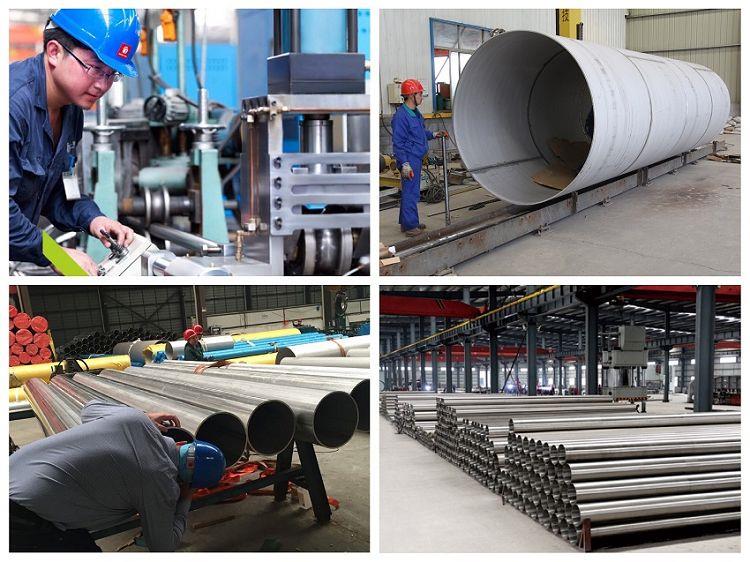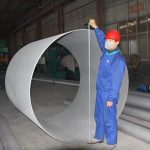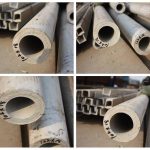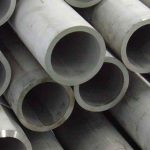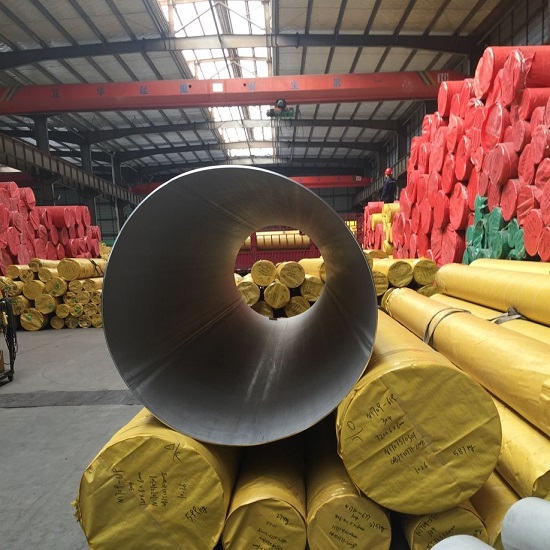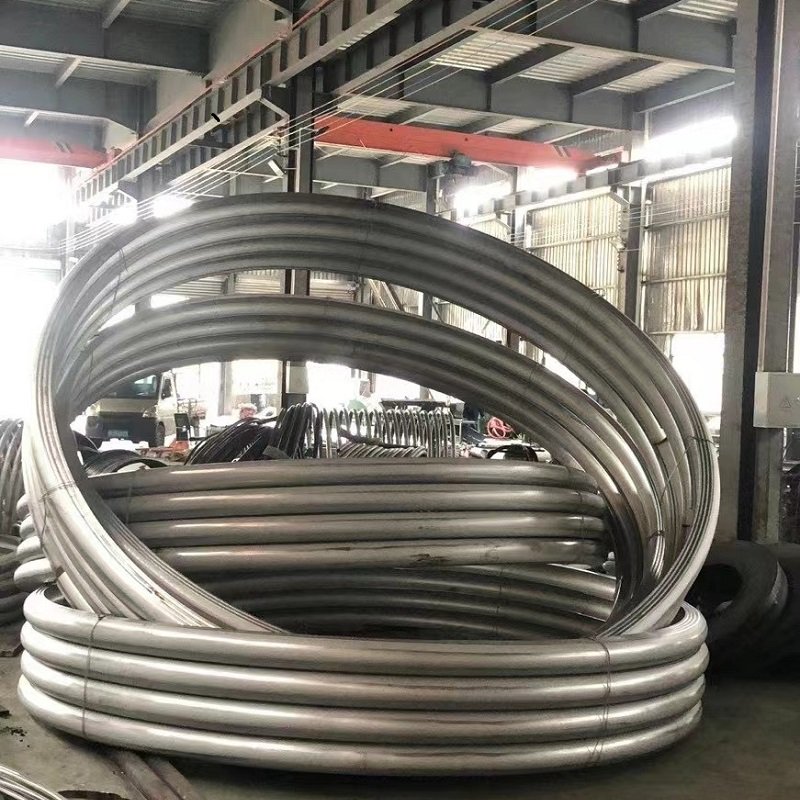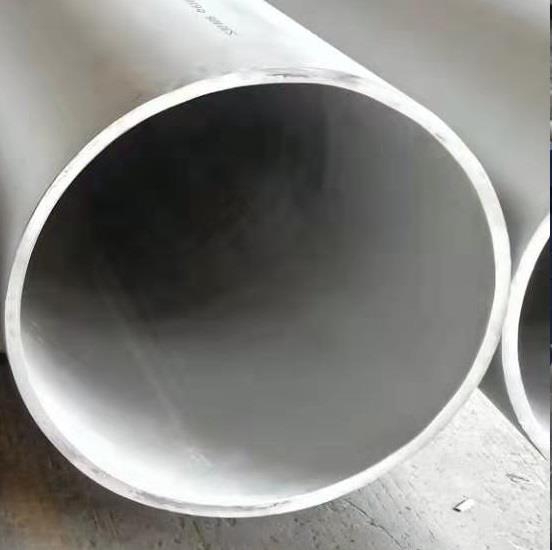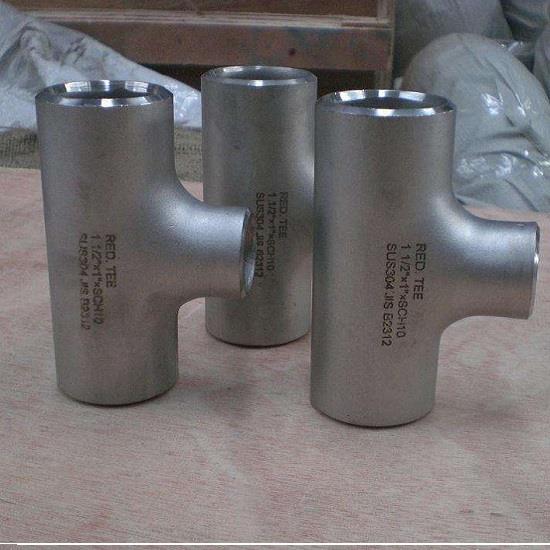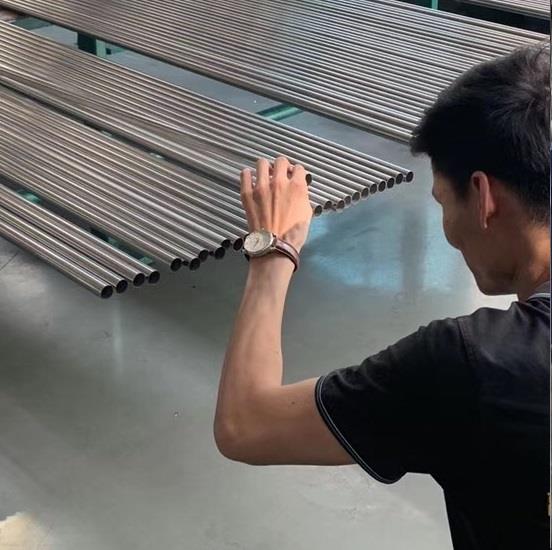Simplify the main production processes: round steel → re-inspection → peeling → blanking → centering → heating → perforation → pickling → flat head → inspection and grinding → cold rolling (cold drawing) → degreasing → heat treatment → straightening → pipe cutting (customized ruler) → pickling/passivation → finished product inspection (eddy current, ultrasonic, water pressure) → packaging and storage.
- Round steel cutting: After receiving the round steel from the raw material warehouse, calculate the cutting length of the round steel according to the process requirements, and mark the section on the round steel. After the bow saw is started, the grinding wheel will be cut along the section line, and the cut circle will be Steel is stacked separately according to steel type, furnace number, production batch number, and specifications, and the ends are distinguished by paint of different colors.
- Centering: When centering the cross-arm drilling machine, first find the center point on a section of the round steel, drill a sample hole, and then fix it vertically on the drilling machine workbench for centering. After centering, the round bars are stacked separately according to steel type, furnace number, specification and production batch number.
- Peeling: Peeling is carried out after the incoming materials pass the inspection. Peeling includes lathe peeling and cyclone cutting. Lathe peeling is performed on the lathe using a clamp-by-top processing method. Cyclone cutting involves hoisting the round steel onto the machine tool. Carry out whirlwind cutting.
- Surface inspection: The peeled smooth round steel shall be inspected for quality, and existing surface defects shall be marked, and the grinding personnel shall grind them until they are qualified. The round bars that have passed the inspection are stacked separately according to steel type, furnace number, specification, and production batch number.
- Round steel heating: Round steel heating equipment includes gas-type inclined-bottom furnaces and gas-type box furnaces. When large quantities of materials are supplied, the gas-type tilt-bottom furnaces are used for heating, and when small quantities of materials are supplied, the gas-type box furnaces are used. When entering the furnace, round bars of different steel types, furnace numbers, and specifications are separated by old outer films. When the round bars are heated, the steel turners use special tools to turn the round bars to ensure that the round bars are heated evenly.
- Hot rolling piercing: use piercing unit and air compressor. According to the specifications of the perforated round steel, the corresponding guide plate and molybdenum plug are selected, and a punching machine is used to perforate the heated round steel. The pierced barren pipe is randomly put into the pool for full cooling.
- Inspection and grinding: Inspect the inner and outer surfaces of the raw pipe to be smooth and smooth, and there shall be no scratches, cracks, interlayers, deep pits, serious thread marks, tower iron, fried strips, Baotou and sickle heads. Surface defects of unused pipes can be eliminated by local grinding. The waste pipes that have passed the inspection or the waste pipes that have passed the inspection after repairing minor defects will be bundled by the workshop bundlers as required, and stacked separately according to the steel type, furnace number, specification, and production batch number of the waste pipes.
- Straightening: The incoming pipes from the perforation workshop are packed in bundles. The shape of the incoming waste pipe is curved and needs to be straightened. The equipment used for straightening is vertical straightening machine, horizontal straightening machine and vertical hydraulic press (used for pre-straightening when the steel pipe has a large bend). In order to prevent the steel pipe from jumping during straightening, a nylon sleeve is used to restrict the steel pipe.
- Pipe cutting: According to the production plan, the straightened raw pipe needs to be cut at the beginning and end, and the equipment used is a grinding wheel cutting machine.
- Pickling: The straightened steel pipe needs to be pickled to remove the oxide scale and impurities on the surface of the raw pipe. Steel pipes are pickled in the pickling workshop. Use a crane to slowly lift the steel pipes into the pickling tank for pickling. After pickling, the steel pipes are first cleaned in the water washing tank, and then the inner holes and outer surfaces of the steel pipes are rinsed one by one with high-pressure water.
- Grinding, endoscopic inspection and internal polishing: The pickled steel pipes that pass the pickling process enter the outer surface grinding process. The polished steel pipes undergo endoscopic inspection. Unqualified products or processes with special requirements require internal polishing. deal with.
- Cold rolling process/cold drawing process
Cold rolling: The steel pipe is rolled through the rolls of the cold rolling mill and undergoes continuous cold deformation to change the size and length of the steel pipe. Cold-rolled steel pipes have faster forming speed, large deformation and high output.
Cold drawing: Use a cold drawing machine to expand and reduce the wall of the steel pipe without heating to change the size and length of the steel pipe. The cold-drawn steel pipe has high dimensional accuracy and good surface finish. The disadvantage is that the residual stress is large, and Large-diameter cold-drawn pipes require more times and the finished product is formed slowly. The specific processes of cold drawing include:
① Heading and welding: Before cold drawing, one end of the steel pipe needs to be headed (small diameter steel pipe) or welded (large diameter steel pipe) to prepare for the drawing process. When processing a small amount of special specification steel pipes, it needs to be heated before starting.
② Lubrication and baking: Before cold drawing, the inner hole and outer surface of the steel pipe after welding (welding head) need to be lubricated. The steel pipe coated with lubricant must be dry before cold drawing.
③ Cold drawing: After the lubricant is dried, the steel pipe enters the cold drawing process. The equipment used in cold drawing is a chain cold drawing machine and a hydraulic cold drawing machine.
- Degreasing: The purpose of degreasing is to remove the rolling mill oil attached to the inner wall and outer surface of the rolled steel pipe by rinsing, so as to avoid contaminating the steel surface during annealing and preventing carbonization.
- Heat treatment: Heat treatment restores the shape of the material through recrystallization and reduces the deformation resistance of the metal. The heat treatment equipment is a natural gas solid solution heat treatment furnace.
- Pickling of finished products: The steel pipes after cutting are subjected to pickling of finished products. The purpose is to passivate the surface and form a protective oxide film on the surface of the steel pipe to enhance the performance of the steel pipe.
- Finished product inspection: The process of finished product inspection and testing is mainly table inspection → eddy probe → ultrasonic probe → water pressure → air pressure. The surface inspection is mainly to manually check whether there are any defects on the surface of the steel pipe, and whether the length and outer wall size of the steel pipe are qualified; the eddy detection is mainly to use the eddy current flaw detector to check whether there are loopholes in the steel pipe; the ultrasonic detection is mainly to use the ultrasonic flaw detector to check whether the steel pipe is cracked inside and outside; water pressure , air pressure is to use hydraulic press and air pressure machine to detect whether the steel pipe is leaking or air leaking, so as to ensure that the steel pipe is intact.
- Packaging and warehousing: The steel pipes that pass the inspection enter the finished product packaging area for packaging. Materials used for packaging include perforated caps, plastic bags, snakeskin cloth, wooden boards, stainless steel belts, etc. The outer surfaces of both ends of the wrapped steel pipes are lined with small wooden boards and tied with stainless steel straps to prevent contact between the steel pipes during transportation and cause collisions. The packaged steel pipes enter the finished product stacking area.

